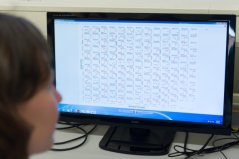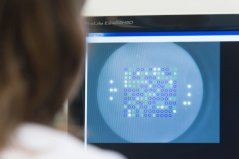
Apparatuur
PamStation®12
The PamStation uses arrays to monitor the activities of kinases or co-regulator recruitment upon ligand mediated activation by nuclear receptors. Kinases and nuclear receptors have key roles in development and homeostasis as well as in many diseases such as obesitas, diabetes and cancer.
This technique can be used for a wide range of applications, enabling researchers to study these activities and their biological effects.
Applications
The technology can be used for life sciences research, such as food safety, toxicology, agro-biotechnology, molecular biology, epigenetics and systems biology.
This instrument can be applied for a wide variety of applications measuring endpoints of key importance in development and homeostasis and the resulting biological effects including:
- Nuclear receptor assays: give detailed information on co-activator and co-repressor recruitment upon receptor binding of ligands of more than 20 different nuclear receptor types.
- Kinase assays: report activities of tyrosine and or serine/threonine kinases from cell line or tissue lysates and are used to find novel targets, determine activities of kinase inhibitor drugs or novel food ingredients and elucidate their mechanism of action.
The PamStation12 can be used in a variety of biological or clinical research studies, such as:
- Pathway elucidation studies
- Target discovery studies
- Kinase substrate identification studies
- Enzymological studies
- Diagnostic biomarker identification studies
- Prognosis biomarker discovery studies
- Predictive biomarker discovery studies
- Toxicological biomarkers studies
- Toxicological pathway studies
- Biomarkers classification study
- Compound classification studies
- Alternatives for reporter gene assays
- Alternatives for animal studies
- Target interaction studies
- Clinical utility marker studies
Technical details
The PamStation®12 platform is composed of:
- Peptide microarrays (PamChip® arrays)
- Workstation (PamStation® hardware)
- Data analysis & interpretation package (BioNavigator)
Principle
PamGene’s flow-through arrays technology is based on measurement of i) peptide phosphorylation by protein kinases or ii) nuclear receptor - ligand - coregulator interaction.
The peptides are immobilized on a dedicated microarray and detection uses fluorescently labelled antibodies. These microarrays consist of a highly porous ceramic membrane on which 144 or 154 peptide substrates are immobilized. On each PamChip®4, four arrays are combined.
The assay detects kinase activity or nuclear receptor – coregulator interaction mostly in kinetic assays over the course of about 1 hour. This is accomplished by an up and down movement of the sample solution through the array, giving the kinases or nuclear receptors, maximal opportunity to phosphorylate or bind the peptides on each array When the solution is underneath the array the CCD camera in the workstations will take an image of each array. The incubation, washing, dispensing of reagents and imaging of the PamChip® arrays is done in a fully automated workstation: the PamStation®12. The PamStation®12 takes typically 15 images during the incubation of one hour. The data workflow consisting of image quantification, quality control, statistical analysis, visualization and interpretation is performed using the BioNavigator software.

